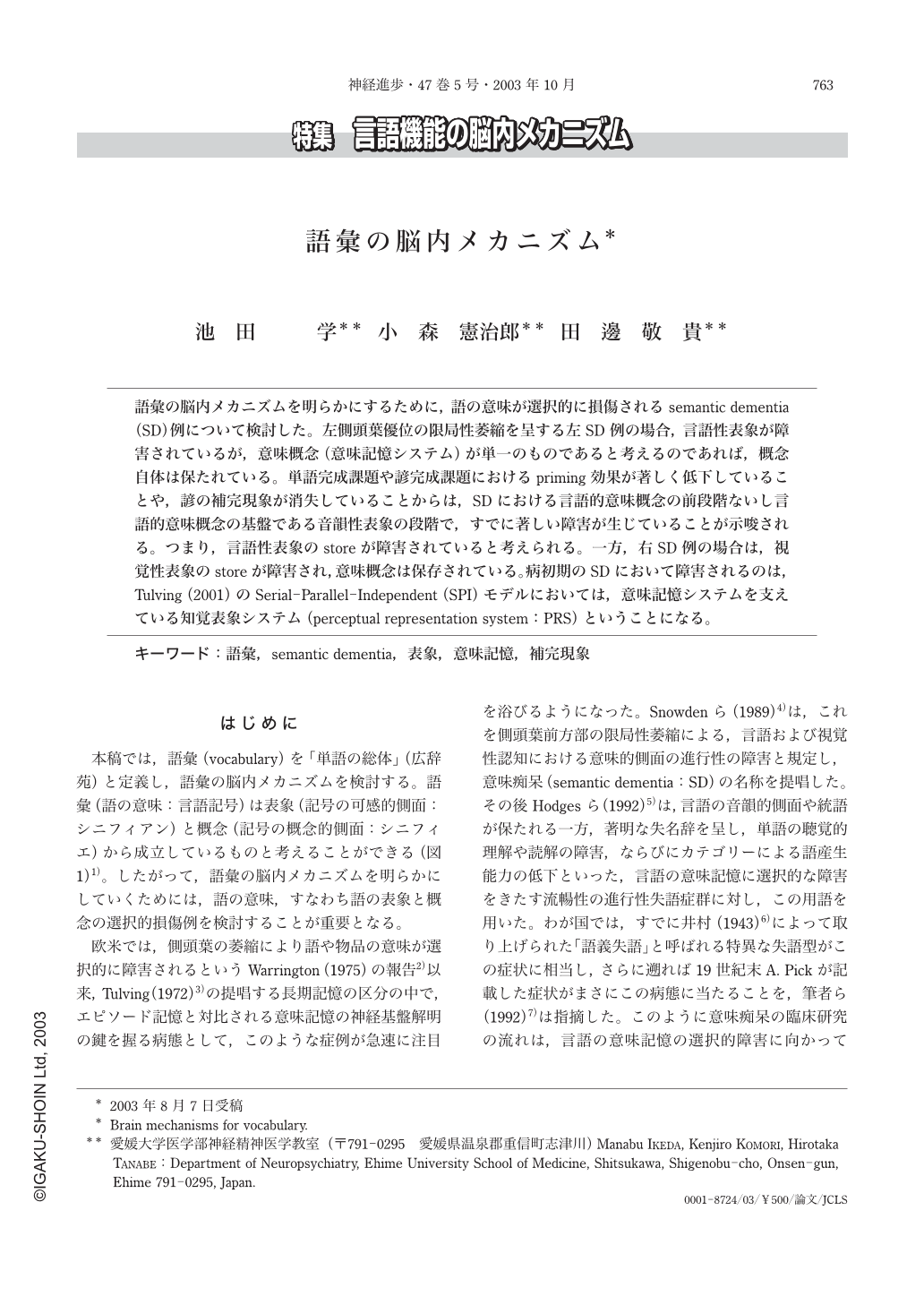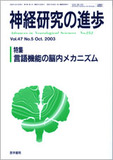Japanese
English
- 有料閲覧
- Abstract 文献概要
- 1ページ目 Look Inside
語彙の脳内メカニズムを明らかにするために,語の意味が選択的に損傷されるsemantic dementia(SD)例について検討した。左側頭葉優位の限局性萎縮を呈する左SD例の場合,言語性表象が障害されているが,意味概念(意味記憶システム)が単一のものであると考えるのであれば,概念自体は保たれている。単語完成課題や諺完成課題におけるpriming効果が著しく低下していることや,諺の補完現象が消失していることからは,SDにおける言語的意味概念の前段階ないし言語的意味概念の基盤である音韻性表象の段階で,すでに著しい障害が生じていることが示唆される。つまり,言語性表象のstoreが障害されていると考えられる。一方,右SD例の場合は,視覚性表象のstoreが障害され,意味概念は保存されている。病初期のSDにおいて障害されるのは,Tulving(2001)のSerial-Parallel-Independent(SPI)モデルにおいては,意味記憶システムを支えている知覚表象システム(perceptual representation system:PRS)ということになる。
はじめに
本稿では,語彙(vocabulary)を「単語の総体」(広辞苑)と定義し,語彙の脳内メカニズムを検討する。語彙(語の意味:言語記号)は表象(記号の可感的側面:シニフィアン)と概念(記号の概念的側面:シニフィエ)から成立しているものと考えることができる(図1)1)。したがって,語彙の脳内メカニズムを明らかにしていくためには,語の意味,すなわち語の表象と概念の選択的損傷例を検討することが重要となる。
欧米では,側頭葉の萎縮により語や物品の意味が選択的に障害されるというWarrington(1975)の報告2)以来,Tulving(1972)3)の提唱する長期記憶の区分の中で,エピソード記憶と対比される意味記憶の神経基盤解明の鍵を握る病態として,このような症例が急速に注目を浴びるようになった。Snowdenら(1989)4)は,これを側頭葉前方部の限局性萎縮による,言語および視覚性認知における意味的側面の進行性の障害と規定し,意味痴呆(semantic dementia:SD)の名称を提唱した。その後Hodgesら(1992)5)は,言語の音韻的側面や統語が保たれる一方,著明な失名辞を呈し,単語の聴覚的理解や読解の障害,ならびにカテゴリーによる語産生能力の低下といった,言語の意味記憶に選択的な障害をきたす流暢性の進行性失語症群に対し,この用語を用いた。わが国では,すでに井村(1943)6)によって取り上げられた「語義失語」と呼ばれる特異な失語型がこの症状に相当し,さらに遡れば19世紀末A. Pickが記載した症状がまさにこの病態に当たることを,筆者ら(1992)7)は指摘した。このように意味痴呆の臨床研究の流れは,言語の意味記憶の選択的障害に向かっていった。
To address the brain mechanisms for vocabulary, we analyzed cognitive features in semantic dementia(SD)due to temporal lobar atrophy. SD shows selective breakdown of comprehending words, faces and objects. Patients with predominantly left temporal lobar atrophy(SD-L), characterized by“gogi aphasia”showed more marked deterioration of verbal production and comprehension compared to patients with greater abnormality on the right(SD-R). However, SD-L patients could visually identify objects. SD-L patients were profoundly impaired in word-completion priming and proverb completion task. These patterns of deficits in SD-L suggest that the store of verbal representation is severely impaired with relatively preserved semantic system and the left temporal lobe may be more important in verbal representation than the right. On the contrary, patients with SD-R showed more marked deterioration of performances in the object completion tests than SD-L patients. This suggests neural substrates of visual representation may be subserved by the right temporal lobe mainly. These deficits in SD might be the deterioration of Perceptual Representation System(PRS)which support semantic system in the Tulving's Serial-Parallel-Independent model(2001).

Copyright © 2003, Igaku-Shoin Ltd. All rights reserved.


